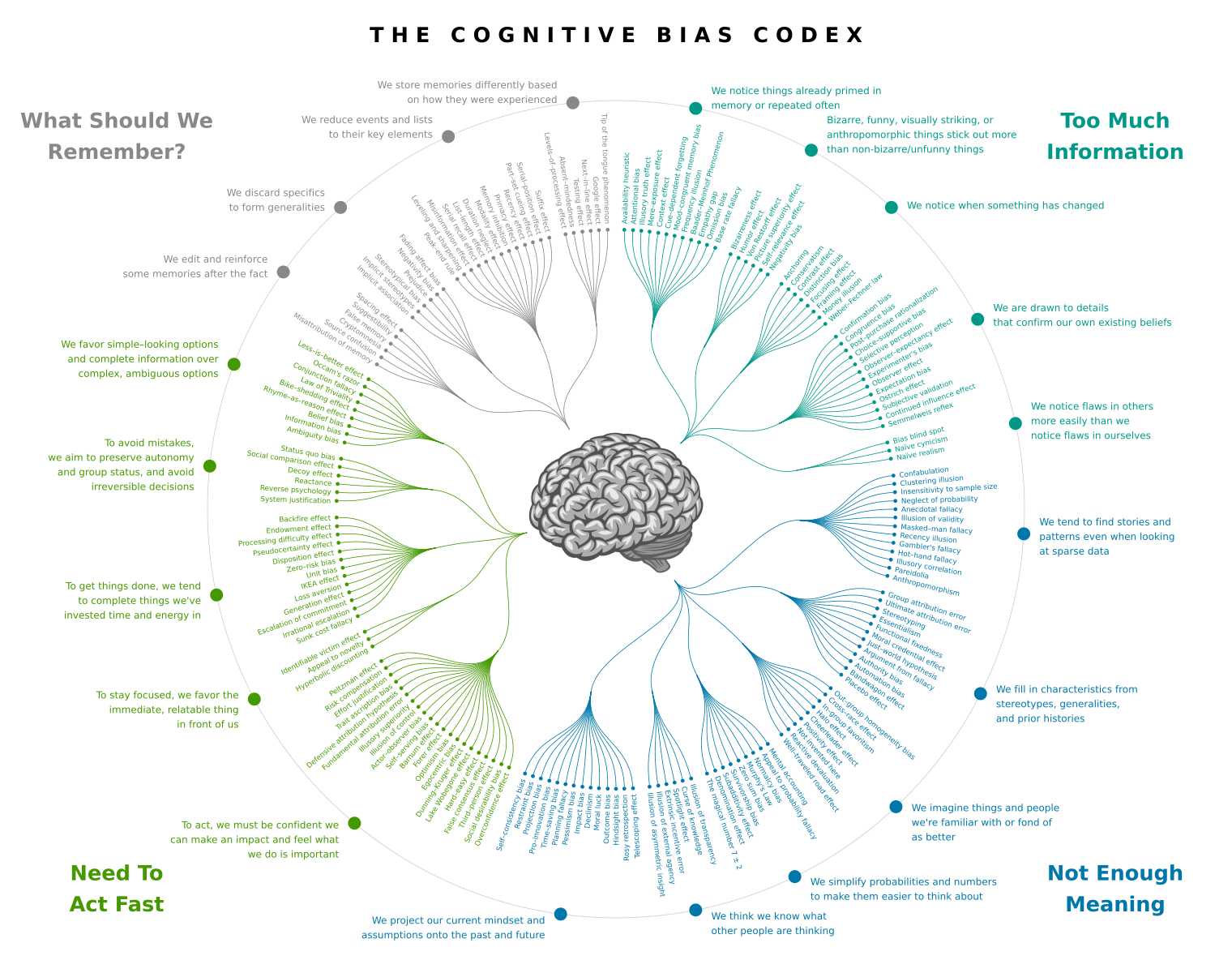Cultivating farsightedness—seeing beyond the immediate to grasp the bigger picture—is a crucial skill in today’s fast-paced world. This skill helps us avoid superficial judgments that can lead to unintended consequences. Last week, I briefly touched on this in “My thoughts on the thing that happened.” Now, let’s explore some mental traps that can distort our interpretations: cognitive biases.
The Cognitive Bias Codex, a fascinating and thorough map, lists 180 ways our minds can mislead us. Understanding even a few of these biases can significantly impact our decisions and interactions.

Here are several key biases to be aware of:
- Confirmation Bias: The tendency to seek out information that supports our pre-existing beliefs while ignoring contradictory evidence. This creates an echo chamber effect, especially amplified by social media algorithms that tailor content to our perceived beliefs.
- Anchoring Bias: The reliance on the first piece of information received—the “anchor”—when making decisions. This initial information sets a mental benchmark, influencing subsequent judgments.
- Availability Heuristic: Overestimating the importance of information that is readily available or recent, often sensational events. For instance, after seeing multiple news reports about airplane crashes, we might overestimate the danger of flying, even though it’s statistically safer than driving.
- Hindsight Bias: The tendency to view events as having been predictable after they occur, leading to overconfidence in predicting outcomes and unfair criticism of past decisions.
- Bandwagon Effect: The tendency to adopt beliefs or behaviors because many other people do so, leading to groupthink and suppressing dissenting opinions.
- Self-Serving Bias: The habit of attributing positive events to one’s own character while blaming negative events on external factors, which can distort our view of our abilities and circumstances.
These biases don’t just shape our opinions; they can trap us in a limited worldview. Strong opinions, especially those formed early in life, often become rigid belief systems, turning into mental cages that define how we see ourselves and the world.
Disclaimer: Though the strict division between right- and left-brain thinking has been largely debunked, recognizing the unique contributions of each hemisphere can still provide useful insights into our cognitive processes.
Ian McGilchrist, in “The Master and His Emissary: The Divided Brain and the Making of the Western World” explores how our brains present two different versions of reality.
- The left hemisphere focuses on detail and categorization, aiding practical manipulation of the world. It excels at breaking down and analyzing information but can lead to a fragmented view of reality.
- The right hemisphere provides a broader, interconnected view, allowing us to see the bigger picture and understand things in context. It’s more abstract and conceptual.
Unfortunately, we often neglect this right-brain perspective. It’s not so graspable. It’s where the acknowledgment of the unknown resides.
This imbalance contributes to various societal issues, such as an overemphasis on individualism and material success at the expense of community and well-being. We see this in our pursuit of happiness—focusing on wealth or status without considering the deeper, interconnected aspects of a fulfilling life.
This narrow focus can also exacerbate mental health issues, as we struggle to reconcile our inner experiences with external pressures and societal expectations.
So, how do we break free from these cognitive traps?
One key is to question our initial reactions and assumptions. Being mindful of our thought processes and challenging ourselves to consider alternative viewpoints is essential. Engaging with a wide range of opinions can help us escape echo chambers and broaden our understanding.
We can train ourselves to create space between our initial reactions and responses, allowing us to reflect on our biases and make more informed decisions. Critical thinking exercises, like debating both sides of an argument or playing devil’s advocate, can also sharpen our reasoning skills and reduce the impact of biases.
I think it’s also important to remind yourself that the journey toward greater understanding and clarity is not just about individual growth—it’s about fostering these skills within our communities and leadership.
Leaders who are aware of their biases can make balanced and informed decisions, seeing past surface-level issues to address deeper, systemic factors. This kind of farsightedness is crucial.
As we continue to explore these themes, I encourage you to reflect on how your biases might shape your perceptions and decisions. Engage in conversations that challenge your viewpoints, seek diverse perspectives, and practice mindfulness in your daily life.
The journey to clearer thinking and farsightedness is ongoing, but the rewards—greater understanding, wisdom, empathy, and connection—are well worth the effort.
Until next time,
Jeff Depatie